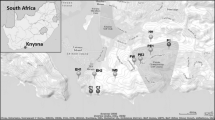Summary
Larvae and pupae of lycaenid butteflies are often associated with ants: this is usually a mutualism in which ants guard the lycaenids from natural enemies, and the lycaenid larvae and pupae provide sugars and amino acids for the ants. A possible consequence of the interaction is spatially correlated ant and lycaenid distributions, but the phenomenon is poorly documented. We examined the lycaenid Plebejus argus, which is tended by Lasius ants. Within habitat patches, P. argus eggs, larvae and pupae were all spatially associated with Lasius. On a larger scale, the densities of butterflies in different habitat patches and populations, and whether the butterfly was present or not, were correlated with Lasius ant densities. The association of P. argus with Lasius ants is consistent among populations, and occurs at several spatial scales. Other aspects of the ecology of P. argus are more variable.
Similar content being viewed by others
References
Atsatt PR (1981) Ant-dependent food plant selection by the mistletoe butterfly Ogyris amaryllis (Lycaenidae). Oecologia 48:60–63
Dennis RLH (1972) Plebejus argus (L.) caernensis Thompson. A stenoecious geotype. Entomol Rec J Var 84:100–108
Dennis RLH (1977) The British butterflies: their origin and establishment. EW Classey, Oxford
Fiedler K (1988) Die Beziehungen von Bläulingspuppen (Lepidoptera: Lycaenidae) zu Ameisen (Hymenoptera: Formicidae). Nachr Entomol Ver Apollo, Frankfurt, NF, 9, Heft 1:33–58
Fiedler K, Maschwitz U (1988) Functional analysis of the myrmecophilous relationships between ants (Hymenoptera: Formicidae) and lycaenids (Lepidoptera: Lycaenidae). II Lycaenid larvae as trophobiotic partners of ants — a quantitative approach. Oecologia 75:204–206
Jordano D, Thomas CD (1992) Specificity of an ant-lycaenid interaction. Oecologia 91:431–438
Jutzeler D (1989) Kann das Weibchen von Plebejus argus (Linnaeus 1761) Ameisen riechen? (Lepidoptera, Lycaenidae). Mitt Entomol Ges Basel NF 39:150–159
Malicky H (1969) Versuch einer Analyse der ökologischen Beziehungen zwischen Lycaeniden (Lepidoptera) und Formiciden (Hymenoptera). Tijdschr Entomol 112:213–298
Maschwitz U, Wüst M, Schurian K (1975) Bläulingsraupen als Zuckerlieferanten für Ameisen. Oecologia 18:17–21
Mendel H, Parsons E (1987) Observations on the life history of the silver-studded blue, Plebejus argus L. Trans Suffolk Nat Soc 23:208
Pierce NE (1983) The ecology and evolution of symbioses between lycaenid butterflies and ants. Ph.D. thesis, Harvard Univ, Cambridge, Mass
Pierce NE (1989) Butterfly-ant mutualisms. In: Grubb PJ, Whittaker JB (eds) Towards a more exact ecology. Br Ecol Soc Symp 30:299–324
Pierce NE, Easteal S (1986) The selective advantage of attendant ants for the larvae of a lycaenid butterfly Glaucopsyche lygdamus. J Anim Ecol 55:451–462
Pierce NE, Elgar MA (1985) The influence of ants on host plant selection by Jalmenus evagoras, a myrmecophilous lycaenid butterfly. Behav Ecol Sociobiol 16:209–222
Pierce NE, Mead PS (1981) Parasitoids as selective agents in the symbioses between lycaenid butterfly caterpillars and ants. Science 211:1185–1187
Pierce NE, Kitching RL, Buckley RC, Taylor MFJ, Benbow K (1987) The costs and benefits of cooperation for the Australian lycaenid butterfly, Jalmenus evagoras, and its attendant ants. Behav Ecol Sociobiol 21:237–248
Pollard E (1977) A method of assessing changes in the abundance of butterflies. Biol Conserv 12:115–134
Pontin AJ (1990a) Plebejus argus L. (Lep., Lycaenidae) pupae in nests of Lasius niger (L) (Hym., Formicidae). Entomol Monthly Mag 126:73
Pontin AJ (1990b) The low specificity of Plebejus argus (L.) (Lep., Lycaenidae) to species of Lasius (Hym., Formicidae). Entomol Monthly Mag 126:196
Ravenscroft NOM (1986) An investigation into the distribution and ecology of the silver-studded blue butterfly (Plebejus argus L.) in Suffolk — an interim report. Suffolk Trust for Nature Conservation, Saxmundham, Suffolk
Ravenscroft NOM (1990) The ecology and conservation of the silver-studded blue butterfly Plebejus argus L. on the Sandlings of East Anglia, England. Biol Conserv 53:21–36
Read M (1985) The silver-studded blue conservation report. MSc thesis, Imperial College
Rodríguez J, Fernández Haeger J, Jordano D (1991a) El ciclo biológico de Plebejus argus (Linnaeus, 1758) en el Parque Nacional de Doñana (SW de España). (Lepidoptera: Lycaenidae.) SHILAP Revta Lepid 19(76):241–252
Rodríguez J, Fernández Haeger J, Jordano D (1991b) El ciclo biológico de Cyaniris semiargus (Rottemburg, 1775) en el Parque Nacional de Doñana (SW de España) (Lep., Lycaenidae). SHILAP Revta Lepid 19(75):175–190
SAS Institute Inc (1987) SAS/STAT™ Guide for Personal Computers. 6th edition. Cary, North Carolina
Smiley JT, Atsatt PR, Pierce NE (1988) Local distribution of the lycaenid butterfly, Jalmenus evagoras, in response to host ants and plants. Oecologia 76:416–422
Thomas CD (1983) The ecology and status of Plebejus argus L. in North West Britain. MSc thesis, University of Wales, Bangor
Thomas CD (1985a) Specializations and polyphagy of Plebejus argus (Lepidoptera: Lycaenidae) in North Wales. Ecol Entomol 10:325–340
Thomas CD (1985b) The status and conservation of the butterfly Plebejus argus L. (Lepidoptera: Lycaenidae) in North West Britain. Biol Conserv 33:29–51
Thomas CD, Harrison S (1992) Spatial dynamics of a patchily distributed butterfly species. J Anim Ecol 61:437–446
Thomas JA (1983a) The ecology and conservation of Lysandra bellargus (Lepidoptera: Lycaenidae) in Britain. J Appl Ecol 20:59–83
Thomas JA (1983b) A quick method of estimating butterfly numbers during surveys. Biol Conserv 16:195–211
Thomas JA (1991) Rare species conservation: case studies of European butterflies. In: Spellerberg IF, Goldsmith FB, Morris MG (eds) The scientific management of temperate communities for conservation. Br Ecol Soc Symp 31:149–197
Author information
Authors and Affiliations
Rights and permissions
About this article
Cite this article
Jordano, D., Rodríguez, J., Thomas, C.D. et al. The distribution and density of a lycaenid butterfly in relation to Lasius ants. Oecologia 91, 439–446 (1992). https://doi.org/10.1007/BF00317635
Received:
Accepted:
Issue Date:
DOI: https://doi.org/10.1007/BF00317635




